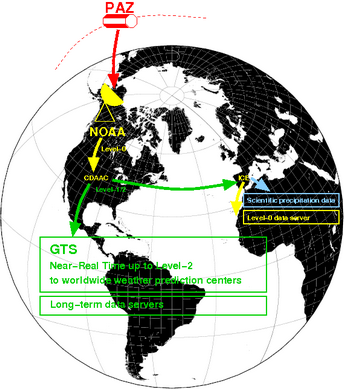ROHP-PAZ

The Ground Segment of the original PAZ mission (SAR instrument solely) did not require any near-real time capabilities. It thus planned a down-link once a day at the PAZ ground station.
Nevertheless, the Radio-Occultation data needs little latency in order to be ingested in the global Numerical Weather Prediction Models (WPM): the time span between a RO event and the arrival of its data at the meteorological centers must be shorter than 3 hours.
An agreement with the North American National Oceanic and Atmospheric Administration (NOAA) will permit the distribution of the RO data in near-real time (NRT). The RO data will be telemetered down to NOAA's Fairbanks station, Alaska, once per orbit (~95 minutes), from where they will follow the processing chain of NOAA's COSMIC RO constellation data: the raw observables are sent to the COSMIC Data Analysis and Archival Center (CDAAC), a center which belongs to the University Corporation for Atmospheric Research (UCAR), where they will be processed into level 1 and 2. Level-1 data are quickly disseminated through the Global Telecommunications System (GTS) of the World Meteorologic Organization (WMO). This system broadcasts meteorological data and alerts in a timely and reliable way to all National Meteorological Services and other WMO members. CDAAC will also maintain a data server and archive with data at level-1 and upper processing levels.
The raw data, with polarimetric information, will be forwarded to the ICE-CSIC/IEEC, from where it will be accessible for research through an Internet data server and archive. This server will also deliver Precipitation information obtained with PAZ polarimetric RO observations.